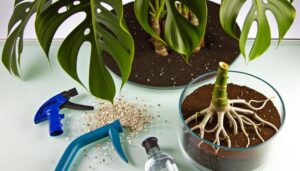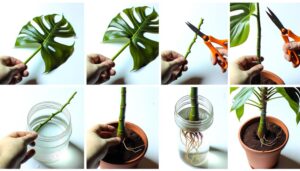How to Propagate Monstera Esqueleto? Expert Techniques!
To propagate Monstera Esqueleto, first, choose a healthy parent plant with vibrant leaves and robust roots. Gather sterilized pruning shears, rooting hormone, and a pot with well-draining soil.
Identify a node with aerial roots and cut just below it using clean shears. Dip the cutting in rooting hormone and plant it in the prepared pot.
Place the cutting in bright, indirect sunlight, and maintain moderate humidity. Monitor root development and avoid overwatering to prevent root rot.
Once sufficient roots have formed, transplant the cutting to a larger pot, ensuring it’s placed in ideal conditions. For more in-depth information, continue exploring.
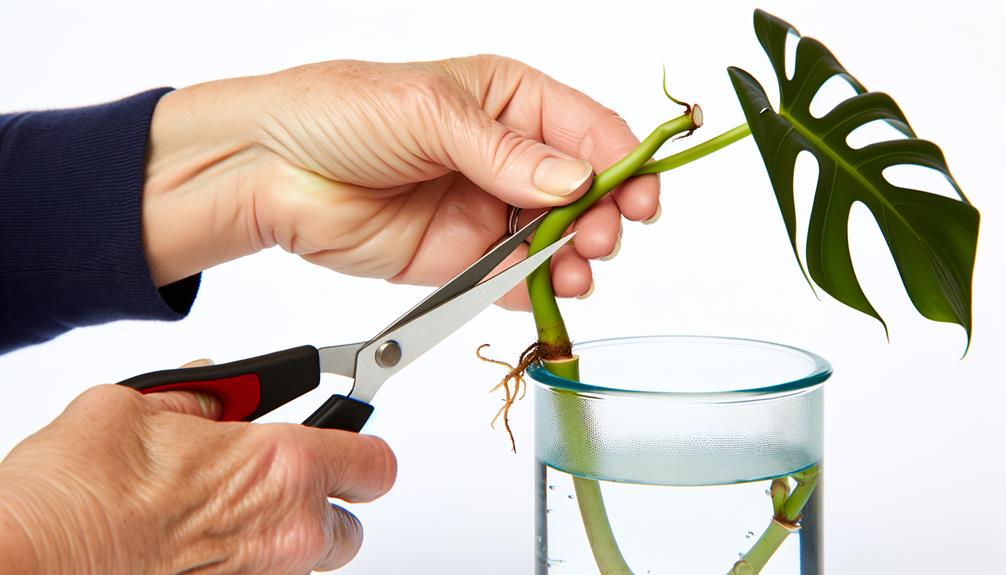
Key Takeaways
- Inspect the parent plant for health, vibrant leaves, firm stems, and robust roots.
- Use sterilized pruning shears to cut a node with aerial roots.
- Dip the node in rooting hormone and plant in well-draining soil.
- Provide bright, indirect sunlight and maintain optimal humidity.
- Regularly check for root development and adjust watering practices as needed.
Choosing a Healthy Parent Plant
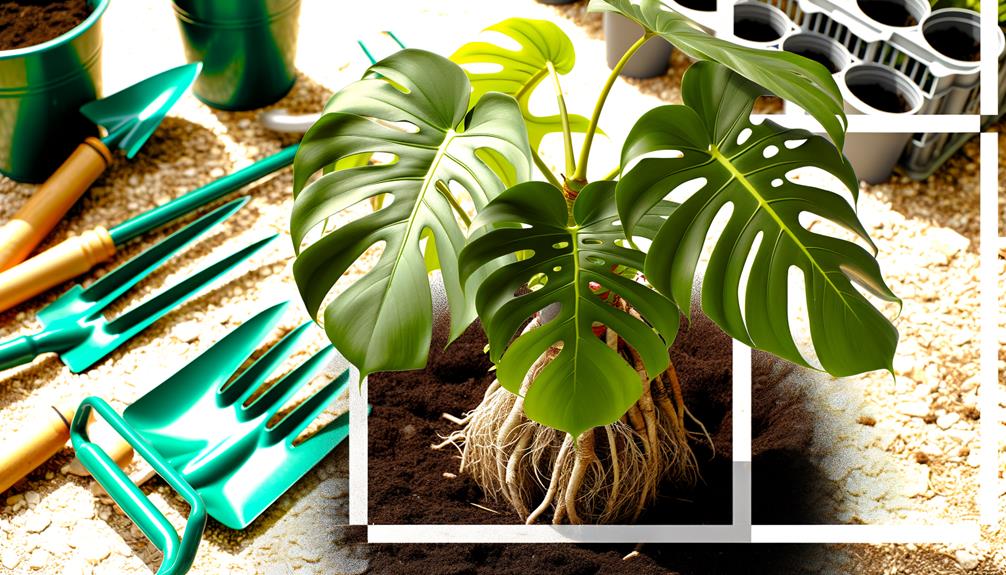
Selecting a vigorous and disease-free Monstera Esqueleto is crucial for successful propagation. Begin by inspecting the plant’s overall health. Look for vibrant green leaves without discoloration or spots, which may indicate fungal or bacterial infections.
Verify the stems are firm and free from lesions or rot. Examine the roots; they should be white and robust, not brown or mushy. Avoid plants showing signs of pests like aphids or spider mites.
Additionally, choose a plant that exhibits strong, consistent growth patterns, as this indicates genetic vigor. This meticulous selection process maximizes your chances of successful propagation, ensuring the new plants inherit the parent’s healthy characteristics. Remember, a healthy parent plant is the cornerstone of effective Monstera Esqueleto propagation.
Gathering Necessary Tools
To guarantee a smooth propagation process, gather essential tools like sterilized pruning shears, rooting hormone, a clean pot, and a well-draining soil mix.
Start by sterilizing your pruning shears with rubbing alcohol to prevent any potential disease transfer. This step is critical to maintaining the health of both the parent plant and the cutting.
Next, have rooting hormone ready to encourage root growth.
Choose a clean pot with drainage holes to prevent water accumulation, which can lead to root rot.
Finally, prepare a well-draining soil mix, ideally one that replicates the plant’s natural habitat. A mix of peat, perlite, and orchid bark works well.
Identifying the Right Node

Identifying the right node is crucial for successful propagation, as this segment contains the necessary growth points for new roots and leaves.
First, locate the nodes on your Monstera Esqueleto. Nodes are the knobby, slightly swollen areas along the stem, typically found where leaves and aerial roots emerge.
Confirm the node you select has a healthy appearance—no signs of rot, discoloration, or damage. Look for a node with visible aerial roots, as these will expedite the rooting process.
Avoid nodes too close to the plant’s base or those without any aerial roots, as they may hinder propagation success.
Making the Perfect Cut
Carefully making the perfect cut is crucial to secure the successful propagation of your Monstera Esqueleto. First, sterilize your pruning shears using isopropyl alcohol to prevent pathogen transmission.
Identify the node you’ve chosen for propagation. Position the shears approximately one-quarter inch below the node, making sure the cut is clean and diagonal. This method increases the surface area for root development.
Apply gentle but firm pressure to execute the cut smoothly. Avoid crushing the stem, as this can impede nutrient uptake.
Dispose of any debris immediately to maintain a sterile environment. Remember, a precise cut enhances the plant’s ability to generate new roots efficiently. Confirm the cutting retains at least one healthy leaf to support photosynthesis.
Preparing the Cutting
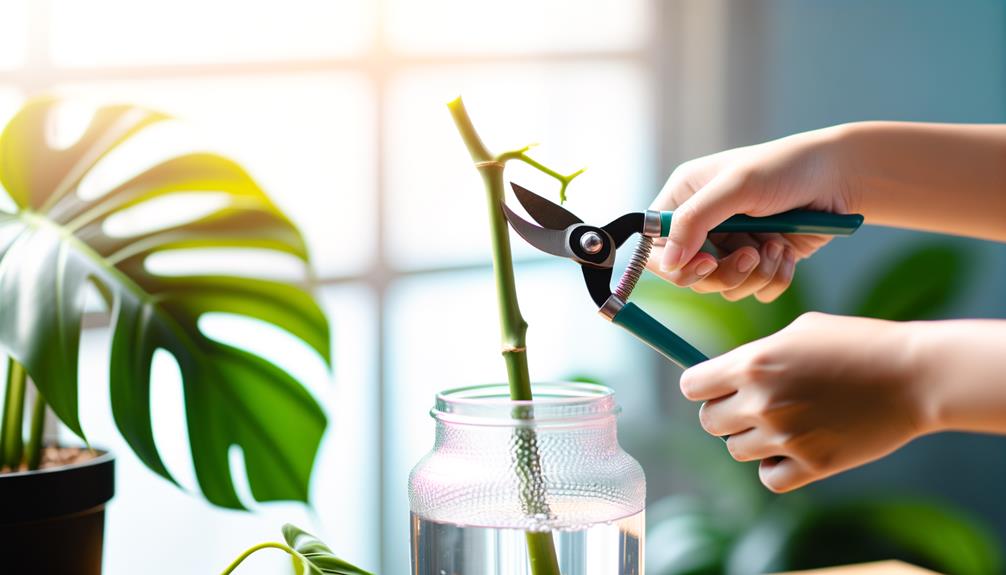
To guarantee successful propagation, select a healthy node from the Monstera Esqueleto.
Always use sterile tools to prevent contamination and promote ideal growth conditions.
Clean your cutting instruments with rubbing alcohol before making the incision.
Use Sterile Tools
After selecting a healthy node, make sure you use sterile tools to prevent the introduction of pathogens during the cutting process.
Start by sterilizing your tools with rubbing alcohol or a diluted bleach solution. Submerge scissors or pruning shears in the solution for approximately five minutes. This step eliminates bacteria, fungi, and viruses that could harm your Monstera Esqueleto.
Dry the tools thoroughly with a clean, lint-free cloth to avoid contamination. Using a sharp, sterile blade, make a clean cut just below the selected node. Ensuring the blade is sharp minimizes tissue damage and promotes quicker healing.
Proper tool sterilization is essential for successful propagation and promotes the health and longevity of your Monstera Esqueleto.
Rooting in Water
Start by ensuring your cuttings are properly prepared, with clean cuts and at least one node.
Select transparent containers to facilitate monitoring of root development.
Regularly check the water level and change it weekly to prevent bacterial growth.
Preparing Cuttings Properly
To properly prepare your Monstera Esqueleto cuttings for rooting in water, make a clean, angled cut just below a node using sterilized pruning shears. This enhances water absorption and minimizes infection risks. Remove any leaves near the cut to prevent rot.
Place the cutting in a container filled with room-temperature water, making sure the node is submerged but leaves stay above water.
| Step | Action | Purpose |
|---|---|---|
| 1 | Cut below a node | Improve water absorption |
| 2 | Remove leaves near the cut | Prevent decay |
| 3 | Submerge node in water | Encourage root development |
Monitor water levels regularly, replacing it weekly to maintain oxygenation and prevent stagnation. This method maximizes your cutting’s chances of successful root development.
Choosing Suitable Containers
When selecting containers for rooting Monstera Esqueleto cuttings in water, choose transparent vessels to easily monitor root development and water clarity. Glass jars or clear plastic containers are ideal.
Guarantee the container’s height supports the cutting’s stem while keeping the leaves above water. Sterilize the vessel with a diluted bleach solution (1 part bleach to 9 parts water) to eliminate pathogens. Rinse thoroughly before use.
Fill the container with tap or distilled water, avoiding chlorinated water which can hinder root growth. Place the cutting in the container, making sure the node is submerged.
Position the container in indirect sunlight to prevent algae growth and promote photosynthesis. Replace the water weekly to maintain prime conditions for root development.
Monitoring Root Growth
Keep a close watch on the Monstera Esqueleto cuttings, making sure that roots are forming healthily and without signs of rot or disease. You’ll need to monitor the water level and quality regularly. Change the water every 5-7 days to prevent bacterial growth.
Look for:
- Root coloration: Healthy roots should be white or light brown.
- Root length: Aim for roots to reach 2-3 inches before transplanting.
- Water clarity: Guarantee the water remains clear; cloudiness indicates contamination.
Utilize a sterile container to avoid pathogens.
Maintain a consistent water temperature between 65-75°F (18-24°C), which is ideal for root development.
If you notice any signs of disease, such as mushy roots or foul odor, promptly remove the affected cuttings.
Rooting in Soil

Rooting a Monstera Esqueleto cutting in soil requires a clean, sharp pair of pruning shears to make precise cuts just below a node. Select a healthy, mature stem with at least one node and an aerial root.
Dip the cut end in rooting hormone to stimulate root development. Fill a well-draining pot with a high-quality potting mix, ensuring it contains perlite or orchid bark for aeration. Create a small hole and insert the cutting, burying the node completely. Firm the soil around the stem to eliminate air pockets.
Water the soil lightly until it’s evenly moist but not waterlogged. Place the pot in a location with bright, indirect light to encourage best rooting.
Providing Proper Conditions
To guarantee successful propagation of Monstera Esqueleto, you must provide ideal light levels, humidity, and temperature.
Position the plant in bright, indirect sunlight to facilitate photosynthesis without leaf burn.
Maintain humidity around 60-70% and keep temperatures between 65-80°F to mimic its native tropical environment.
Ideal Light Levels
While propagating Monstera Esqueleto, make sure the plant receives bright, indirect light to promote growth and root development. Direct sunlight can scorch the leaves, while too little light will impede photosynthesis and root formation.
To achieve ideal light conditions, consider the following:
- Light Source: Place your Monstera Esqueleto near an east or north-facing window.
- Light Intensity: Use sheer curtains to filter direct sunlight if necessary.
- Supplemental Lighting: Employ grow lights if natural light is insufficient, maintaining an intensity of 200-400 foot-candles.
Monitor the plant daily for signs of light stress, such as yellowing leaves or leggy growth. By ensuring the right balance of light, you’ll foster a healthy propagation environment conducive to robust development.
Humidity and Temperature
Maintaining high humidity levels and stable temperatures is crucial for successful propagation of Monstera Esqueleto. Aim for humidity levels between 60-80%. You can achieve this by using a humidifier or placing a tray of water near the plant. Regular misting also helps retain moisture.
Keep the temperature consistently between 65-80°F (18-27°C), avoiding sudden fluctuations. Position your propagation setup away from drafty windows or air vents, as these can cause temperature variations. Using a heat mat can provide additional warmth, promoting root development.
Monitor conditions regularly with a hygrometer and thermometer to ensure ideal levels. These steps create an environment conducive to root growth and overall plant health.
Monitoring Root Development
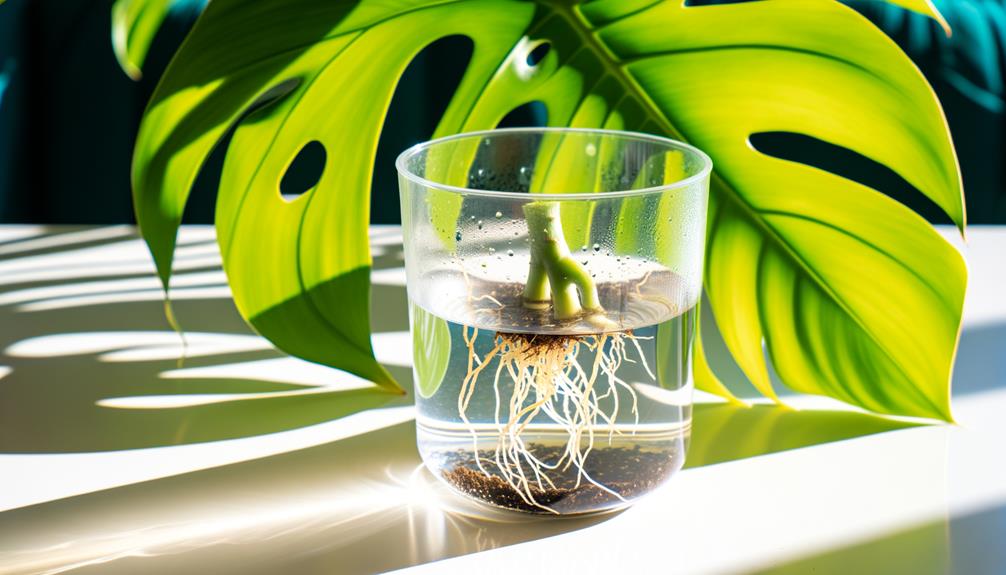
Regularly examine the cutting’s root growth by gently lifting it from the propagation medium, confirming roots are white and healthy. Use a sterilized tool to avoid contamination.
Monitor for signs of:
- Root Rot: Brown, mushy roots indicate overwatering or poor drainage.
- Healthy Growth: White, firm roots indicate proper development.
- Pests: Look for aphids or other pests that can harm the roots.
Maintain consistent moisture levels without waterlogging. Use a hygrometer to measure humidity around the propagation area, keeping it between 60-80%. Additionally, verify the temperature remains stable, ideally between 65-75°F.
If roots appear stunted or discolored, adjust watering practices and check for adequate light exposure. Consistent monitoring guarantees robust root development, critical for healthy Monstera Esqueleto propagation.
Transplanting the New Plant
Once you’ve confirmed the roots are healthy and robust, it’s time to transplant the new Monstera Esqueleto into its permanent pot.
Select a pot with adequate drainage holes and fill it with a well-draining, aerated soil mix.
Gently remove the plant from its current container, taking care not to damage the delicate roots. Place it in the center of the new pot, ensuring the roots spread out naturally.
Fill around the root ball with soil, pressing lightly to eliminate air pockets. Water thoroughly to settle the soil, then place the pot in a location with indirect light and consistent humidity.
Monitor moisture levels closely, ensuring the soil remains slightly damp but not waterlogged.
Conclusion
To wrap up, successfully propagating a Monstera esqueleto involves precise steps from selecting a healthy parent plant to transplanting the new specimen.
Did you know that over 75% of Monstera cuttings root successfully when the right node is chosen and proper conditions are maintained?
This statistic underscores the importance of attention to detail in each phase.
By adhering to these detailed methodologies, you maximize the potential for thriving, vibrant new plants in your collection.



